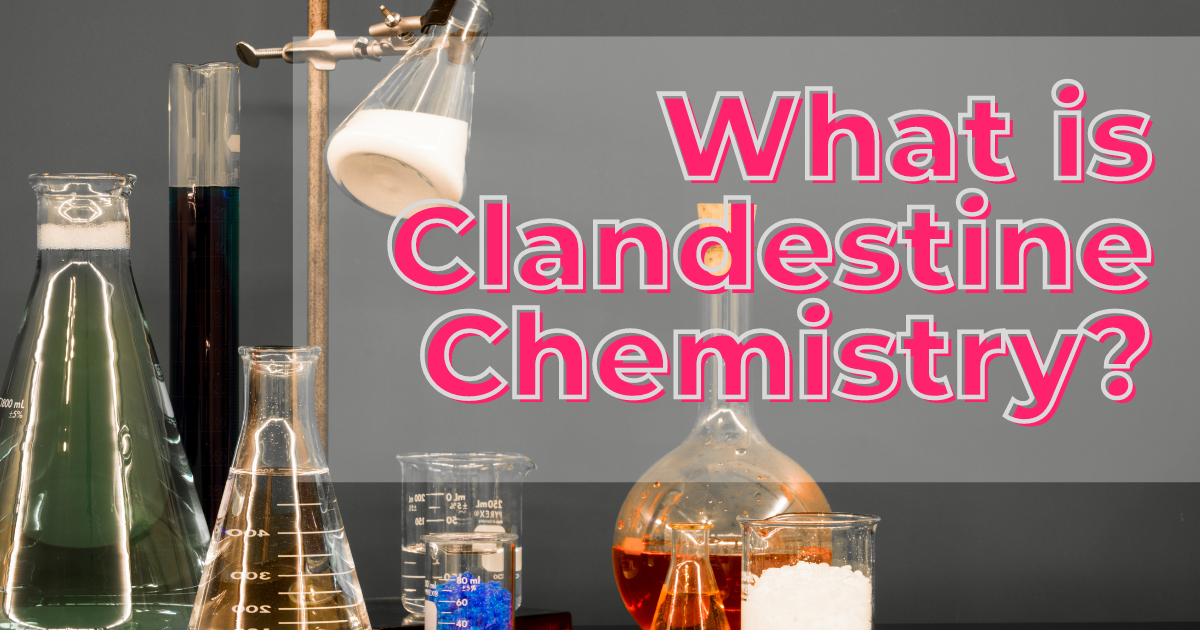What is clandestine chemistry?
Clandestine chemistry is a form of illicit drug manufacturing, typically done in a secret or hidden lab. The chemists in these labs make use of improvised synthesis methods and alternative equipment to create desired drugs for personal use or black/gray market distribution. Clandestine chemistry is illegal in the vast majority of circumstances, partly due to the high level of regulation governing the manufacture of drugs. Penalties are high in the world of clandestine chemistry, but for many that participate in the “tradition,” per se, part of the excitement is finding novel ways to evade law enforcement to create substances that involve complex or new ways of achieving drug synthesis.
How is clandestine chemistry usually done?
Clandestine chemistry can take many forms, from “shake-and-bake” meth production in a Coca-Cola bottle to a large production setup with pharmaceutical-grade equipment in a warehouse. Fentanyl, a common powerful opioid drug, is primarily made in fully-equipped, pharmaceutical-grade labs in China. In contrast, fentanyl is mixed in thrown-together cartel facilities in Mexico much of the time with other drugs in highly unregulated setups; this causes fentanyl to be unequally distributed in illegally pressed pills or other end products. Over the years, clandestine chemists, especially domestic U.S. hobbyists, have experimented with all sorts of production methods, and many of them see the limitations as a personal challenge worth tackling.
Who participates in this “tradition?”
Many of those desperate for intoxication have taken charge of making their own drug of choice. But it’s not just those who are looking for a cheaper alternative to buying drugs in the street. Clandestine chemistry is sometimes also of interest to those who work in scientific labs around the country and find satisfaction in combining their taste for new “research chemicals” with their ingenious ability to synthesize new recreational substances. It’s admittedly interesting to what lengths people will go to find new ways to make recreational drugs. The small communities of those who trade chemistry advice on various forums (such as those who lurk infamous hobbyist website The Hive, otherwise known as “bees”) are incredibly interesting to lay people and experts in forensic studies around the world.
Limits and safeguards
There are laws governing the ability of chemists to acquire the necessary equipment for drug synthesis. The Drug Enforcement Agency (DEA) Diversion Control Division maintains a list of chemicals, products, materials, and equipment that may or may not be used in the clandestine production of controlled substances or chemicals. The surveillance of those purchasing certain kinds of equipment is carried out when individuals are flagged in the Department of Justice’s (DOJ) database. This kind of surveillance system is also a similar system to the ones in place when federal law enforcement agencies are looking for potential domestic terrorist threats due to the manufacture of improvised explosive devices (IEDs).
By governing precursor materials in particular, law enforcement is attempting to limit the ability of clandestine chemists in getting their hands on the necessary building blocks of certain drugs. As previously mentioned, one of the challenges that many in the clandestine chemistry world must overcome is evading bans on precursors to find new ways of manufacturing the target drug.
Famous instances of clandestine chemistry
What is a trap house?
Trap houses are locations where gangs or criminal groups produce cocaine and/or crack in low-income neighborhoods. They’re dangerous locations in residential neighborhoods and can become serious security hazards when protecting families from gang violence and drug use.
Is Breaking Bad an accurate portrayal of meth labs?
Far from the level of sophistication displayed in the show Breaking Bad, meth labs are normally quite dangerous due to the lack of precaution among those making meth. They are arguably the most dangerous form of clandestine laboratory. It’s prudent to assume that meth labs are run by those suffering from severe cognitive obstruction due to meth use. Meth labs are also at extreme risk for spontaneously exploding when toxic and combustible gasses are byproducts of meth production.
Famous clandestine chemists
Owsley Stanley
One of Owsley Stanley’s big claims to fame is being the original consistent supplier of acid to the Grateful Dead and their entourage. A genius at developing incredible sound systems for live music, Stanley began manufacturing acid on the side—a drug that was actually legal and unscheduled at the time he started. Once acid was scheduled by the US Congress, Stanley was taken down by law enforcement and released from prison in 1972, when he went back to working for the Dead.
Nicholas Sand
“Orange sunshine,” one of the most famous varieties of LSD and a 1960s classic hippie drug, was created by Nicholas Sand. Sand successfully evaded prosecution and significant jail time for his interests until 1996, when he was given a 14-year sentence. Sand made millions of doses of LSD, including a whopping 3.6 million doses over the course of 1969 from a small farm.
Total Synthesis II
Known as a key text in learning how to manufacture MDMA, Total Synthesis II contains instructions on its synthesis and how to acquire scientific equipment without having the federal government breathing down your back. The main issue with the text is that it describes how to conduct illegal, unregulated activity, and this kind of activity has been used to spread dangerous, laced substances to the masses. The pseudonymous author, “Strike,” remains anonymous and unnamed.
William Leonard Pickard
William Leonard Pickard is one of the most famous LSD cooks in history. Sporting credentials such as the former deputy director of the Drug Policy Research Program at the University of California, Los Angeles, he was an absolute genius at chemistry and its ability to facilitate recreational drug manufacturing in clandestine laboratories at scale. In 1988, Pickard was arrested and given five years in prison, which he served. Released in 1993, he was then hired by Harvard University where he did academic work on the Soviet Union’s drug scene.
He was arrested again in 2000 amidst a lab move from New Mexico to a renovated, decommissioned Atlas-E missile silo in Kansas. The DEA claims that global LSD supply crashed by 99.5% after he was captured. Pickard received two life sentences, but he was released in 2020 on compassionate grounds.
Learn more
To learn more about how Landmark Recovery treats patients, give us a call at 888-448-0302 today. Our evidence-based treatment methods are tailored to the needs of patients to help them maximize their success. Don’t wait to find treatment. It’s never too early or late.

Choose Recovery Over Addiction
We're here 24/7 to help you get the care you need to live life on your terms, without drugs or alcohol. Talk to our recovery specialists today and learn about our integrated treatment programs.




